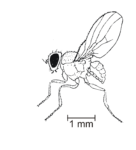Bean fly
Ophiomyia phaseoli ()
Diptera: Agromyzidae
The Bean fly, O. phaseoli, is a worldwide pest but most common in tropical areas in Asia, Europe, and Africa.
Why is O. phaseoli difficult to control?
- it is a tiny insect and can penetrate physical protection measurements like nets
Host plants and damage
Bean flies attack leguminous plants with preference for the genera Phaseolus (beans), Vigna, Cajanus, and Glycine. Female adults pierce leaf tissues with their ovipositor and feed on the extracted liquid. They prefer to feed on young plants. Larvae feed on the main stem of bean plants above the soil line. Infested plants become yellow and stunted. In some cases plants produce adventitious roots. If infestations are severe plants die.
Morphology & biology

Female adults lay 200-300 white eggs (0.35-0.14 mm) one by one under the leaf epidermis. Most hatched larvae mine the leaf to reach the stem. Larvae are small white maggots with a brown head. They bore down to just above the soil line, and pupate.
The pupae appear as small brown cylinder, 2-2.5 mm in length.
Adults are small black flies (1.6-2.5 mm) with transparent wings. The life cycle of O. phaseoli can be completed under tropical conditions in 2-3 weeks.
Monitoring
Because larvae are hidden inside the stem, cut the main stem open and look for mining and the small white maggots.
Pest management
Cultural control
Use early maturing and/or tolerant varieties, and remove dead plants to reduce infestations by O. phaseoli.
Chemical Control
Currently the use of insecticides is the main control measure in practice. This is mainly due to the absence of other reliable control practices. The application of insecticides should be combined with the use of cultural control measures.
Preventive insecticides should be used in areas of high risk. First application is recommended when the plants are at the two-leaf stage. In some cases pre-sowing applications of commonly used systemic insecticides helped to protect young seedlings.
Several insecticides form the earliest use of organics and botanicals to modern insecticides, including insect growth regulators have been reported as effective. It has to be noted that neither Neem nor Bacillus thuringiensis control O. phaseoli.